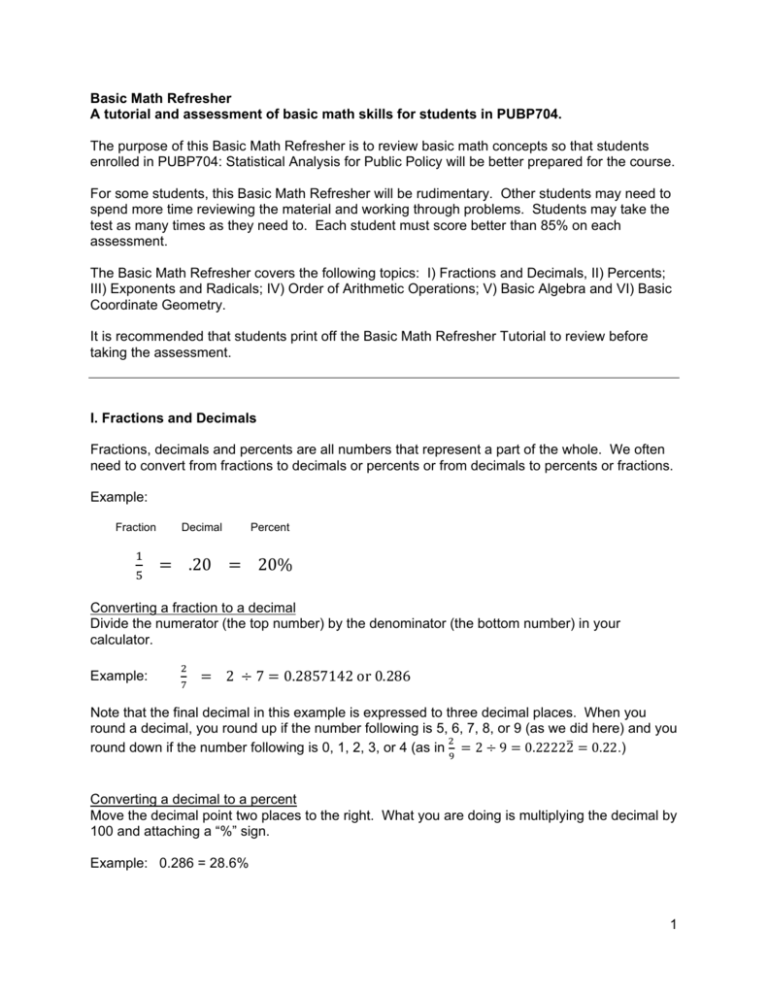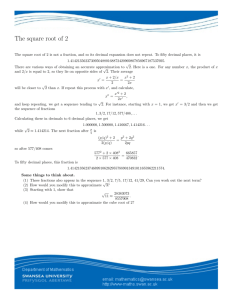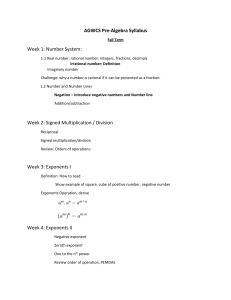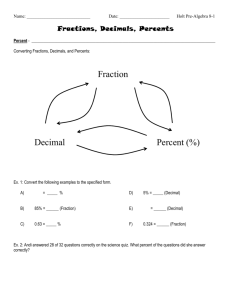Basic Math Refresher
advertisement

Basic Math Refresher A tutorial and assessment of basic math skills for students in PUBP704. The purpose of this Basic Math Refresher is to review basic math concepts so that students enrolled in PUBP704: Statistical Analysis for Public Policy will be better prepared for the course. For some students, this Basic Math Refresher will be rudimentary. Other students may need to spend more time reviewing the material and working through problems. Students may take the test as many times as they need to. Each student must score better than 85% on each assessment. The Basic Math Refresher covers the following topics: I) Fractions and Decimals, II) Percents; III) Exponents and Radicals; IV) Order of Arithmetic Operations; V) Basic Algebra and VI) Basic Coordinate Geometry. It is recommended that students print off the Basic Math Refresher Tutorial to review before taking the assessment. I. Fractions and Decimals Fractions, decimals and percents are all numbers that represent a part of the whole. We often need to convert from fractions to decimals or percents or from decimals to percents or fractions. Example: Fraction Decimal Percent .20 20% Converting a fraction to a decimal Divide the numerator (the top number) by the denominator (the bottom number) in your calculator. Example: 2 7 0.2857142 or 0.286 Note that the final decimal in this example is expressed to three decimal places. When you round a decimal, you round up if the number following is 5, 6, 7, 8, or 9 (as we did here) and you round down if the number following is 0, 1, 2, 3, or 4 (as in 2 9 0.22222 0.22.) Converting a decimal to a percent Move the decimal point two places to the right. What you are doing is multiplying the decimal by 100 and attaching a “%” sign. Example: 0.286 = 28.6% 1 Converting a percent to a decimal Move the decimal point two places to the left. What you are doing is dividing the percentage by 100 and removing the “%” sign. Example: 10.8% = .108 Converting a percent to a fraction Put the number over 100 and reduce (i.e. simplify the fraction so that the top number and bottom number cannot be divided by the same number.) Example: 56% = Convert a decimal to a fraction Determine how many numbers follow the decimal place (i.e. the number of “decimal places.) If there is one decimal place, place the number over 10 and reduce. If there are two decimal places, place the number over 100 and reduce. If there are three decimal places, place the number over 1000 and reduce. And so on. Example: 0.06 = 0.8775 = Adding and subtracting fractions To add or subtract fractions, each fraction must have the same denominator (i.e. the same number in the bottom of the fraction.) If the denominators are different, you must find the lowest common denominator (LCD.) The LCD is the smallest number that is divisible by the denominator of each fraction. Once you determine the LCD, you multiply the top and the bottom by the number that will make the denominator of the fraction equal to the LCD. Then add the two numerators (i.e. numbers in the top) and put that sum over the LCD. Example: =? These fractions have different denominators (3 and 4.) The LCD is 12 because it is the smallest number into which both 3 and 4 are evenly divided. To make the denominator of the first fraction equal to 12, multiply the top and the bottom of the fraction by 4. To make the denominator of the second fraction equal to 12, multiply the top and the bottom of the fraction by 3: So, is the same as 2 Example: =? The LCD is 30. So, is the same as Multiplying and dividing fractions To multiply fractions, simply multiply across the top and across the bottom of the fractions. Example: ? Since 2 x 1 = 2 and 5 x 3 = 15, the answer is To divide fractions, take the reciprocal of the second fraction (i.e. “flip” the second fraction) and multiply it by the first. ? Example: Flip the second fraction and change the divide symbol ÷ to a multiplication symbol x. 3 2 ? 1 5 Then multiply the two fractions 3 6 2 1 5 5 II. Percents Find one number as a percent of another Divide the first number by the second number. Move the decimal two places to the right and attach a “%” sign. Example: The number 15 is what percent of 48? Divide 15 by 48: 15 ÷ 48 = .3125 Move the decimal over two places to the right and add % sign: 31.25% So, 15 is 31.25% of 48 homes. Find a given percent of a number Convert the given percent to a decimal. Multiply the number by that decimal. Example: What is 62.1% of 205? Convert 62.1% into a decimal: 0.621 Multiply 205 by 0.621: 205 * 0.621 = 127.305 So, 127.305 is 62.1% of 205. 3 Find the percent change Calculate the difference between the first and second numbers. Divide that difference by the first number. Convert the resulting decimal to a percent. Example: Calculate the percent increase from 150 to 205. Find the difference: 205 – 150 = 55 Divide difference by starting value: 55 ÷ 150 = 0.3666 Convert decimal to percentage: 36.7% So, the percent increase is 36.7%. III. Exponents and Radicals Positive Exponents Exponents (or powers) indicate that a number is multiplied by itself a certain number of times. In other words, exponents are just a short hand way of writing out a number multiplied by itself. For example, if we see 52 (said “five squared” and sometimes written as 5^2), it is the same thing as 5 * 5. The number that is to be multiplied by itself is called the base. How many times the number is to be multiplied by itself is called the exponent or the power. Be very careful when a negative number is raised to a power. Be sure to keep track of the sign. A negative number multiplied by itself an even number of times will give a positive number result. A negative number multiplied by itself an odd number of times will give a negative number. For example, (-2)2 is equal to (-2)*(-2) = 4. (try it!) Note that the exponent is even and the resulting answer is positive. However, (-2)3 is equal to (-2)*(-2)*(-2) = -8. (try it!) Note that the exponent in this case is odd and the resulting answer is negative. Some calculators have a “^” key that allows you to enter in an expression with an exponent directly. In other words, you can key in 3^2= to get 9. See below. 4 If your calculator does not have a “^” key, then you need to type in the multiplication expression—i.e. for 32 you need to type 3 * 3. Example: Find 7.8652 7.8652 = 7.865 * 7.865 = 61.858 Example: Find (-3.5)5 (-3.5)5 = (-3.5)*(-3.5)*(-3.5)*(-3.5)*(-3.5) = -525.22 Negative Exponents Exponents can also be negative. Negative exponents are treated differently. We will not be using negative exponents in the class. Radicals Radicals (or roots) are sort of the opposite of positive exponents. The radical is the symbol placed over a number. The most common radical is the square root, √ . The square root is the number you need to multiply by itself twice to get the number that is under the radical. For example, the square root of 4, or √4, is equal to 2 (or -2) because when you multiply 2 (or -2) by itself two times, you get 4. 5 There are other higher order roots, such as the cube root, √ , or the fourth root, √ . In these cases, the root is the number that is multiplied by itself 3 or 4 times to get the number under the radical. For example, the cube root of 8, √8, is 2 because 2*2*2 or 23 equals 8. Your calculator should have a square root button. On some calculators, you need to hit the square root button first and then the number. On other calculators, you hit the buttons in reverse order. Note: Your calculator will only show you the positive square root. Graphing calculators will have options for calculating higher order roots. Example: Find √25 Since 5*5 = 25, 5 is a square root of 25. (-5 is also a square root of 25.) IV. Order of Arithmetic Operations When performing a series of arithmetic operations (i.e. addition, subtraction, division, multiplication, exponents), you must perform those operations in a particular order. There is a mnemonic to help you remember the order - PEMDAS: P E M D A S Parentheses Exponents Multiplication Division Addition Subtraction If you have a series of operations, do what’s in parentheses first, then apply exponents, then do any multiplication or division, and finally do any adding or subtracting. Example: 4 3 2 ? 2 Do what’s in parentheses first (find LCD): 2 So now we have 4 3 8 Now apply exponents: 2 So now we have 4 3 2 =? 8=? 6 Now do multiplication: 3 So now we have 4 8 Now do addition and subtraction (find LCD): 4 8 is the same as So our answer is . V. Basic Algebra An algebraic expression is a combination of numbers and variables connected by some mathematical operation, like addition, subtraction, multiplication or division. A variable is a letter (we often use x and y) that represents or is a holding place for a number. In statistical analysis, we will define variables and sometimes will use algebraic equations to relate two (or more) variables. Examples of algebraic expressions: 2x + y, 5d, 10-r Evaluating an Algebraic Expression To evaluate an algebraic expression, replace the variable with the given number. Example: Evaluate 2x + 5 when x = 10. Substitute 10 in for x: 2(10) + 5 Solve: 2*10 + 5 = 25 (Note: 2 * 10 is the same as 2(10).) Equations An equation is two expressions set equal to each other. For example, 2 + 2 = 4 is an equation. Equations can include variables (such as x and y). So, for another example, 3x – 5 = 10 is an equation (though it is only “true” for one value of x.) The solution to an equation is the number, such that when you replace the variable, makes the equation true (i.e. the left side equals the right side.) Example: Determine if any of these values of x is a solution to the following equation: 3x – 5 = 10 a) x = 5 b) x = -5 Substitute in the value for x (x = 5) and solve: 3(5) – 5 = ? 15 – 5 = 10 √ So, x = 5 is a solution because the left hand side equals 10 and the right hand side equals 10. Now try x = -5: 3(-5) – 5 = ? -15 – 5 = -20 χ x = -5 is not a solution because the left hand side equals -20 and the right hand side equals 10. 7 General Solutions to a Linear Equation Sometimes you will be given a linear equation and will need to solve for x (i.e. find a value for x that makes the equation true.) To solve linear equations, remember the following properties: - If you add or subtract a value from both sides of an equation, then the equation is still true. For example: If you have the equation 2x = 4 and add 5 to both sides (like this: 2x + 5 = 4 + 5) then the equation is still true. If you multiply or divide on both sides of an equation by the same number (except 0), then the equation remains true. For example: If you have the equation 2x = 4 and divide both sides by 2 (like this: 2x ÷ 2 = 4 ÷ 2 or x = 2) then the equation will still be true. You use these properties to solve a linear equation. Example: Solve the following equation for x: x + 5 = 12 Subtract 5 from both sides: x + 5 – 5 = 12 – 5 x=7 So, x = 7 is the solution to this linear equation (i.e. 7 is the value for x that makes the equation true.) Example: Solve the following equation for x: 3x – 4 = 8 Add 4 to both sides: 3x – 4 + 4 = 8 + 4 3x = 12 Divide both sides by 3 (to get x alone): 3x ÷ 3 = 12 ÷ 3 x=4 Remember: if you divide by a fraction (e.g. ), it is the same thing as multiplying by the reciprocal or inverse of the fraction (e.g., or 2) VI. Basic Coordinate Geometry Points on a coordinate plane A coordinate plane is often very useful for writing linear equations with two variables. The coordinate plane is formed by a horizontal axis (x-axis) and a vertical axis (y-axis). The two axes intersect at a point called the origin. Points are plotted on a coordinate plane using a set of ordered pairs (x,y.) The first number in the ordered pair indicates how many spaces to move along the x-axis and the second number in the ordered pair indicates how many spaces to move along the y-axis. 8 y-axis origin (1,2) 1 1 Example: x-axis Write the coordinates of the point shown on the coordinate plane. 1 1 Because the point is located 4 units right along the x-axis, the x-value of the point is 4. Because the point is located 1 unit up along the y-axis, the y-value of the point is 1. Therefore, the x, y coordinates of the point are (4,1.) Note: points along the x-axis to the left of the origin are negative and points along the y-axis below the origin are negative. 9




